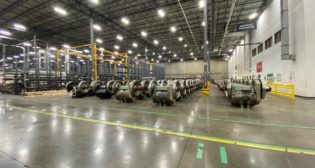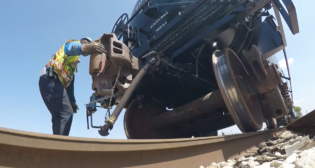
Keybanc’s Barger: Railcar builders in a relatively good place
Written by William C. Vantuono, Editor-in-ChiefSteve Barger of KeyBanc Capital Markets attended the Midwest Association of Rail Shippers Conference, where, in conversations with railcar OEMs, lessors and shippers, he came to the general conclusion that, though 2016 will be a difficult year for the railcar industry, it is in a good position to withstand a period of weaker orders, chiefly due to a large backlog.
“The tone of the conference was more pessimistic than in the recent past, with attendees focusing on key themes including lower freight volumes, increasing cars in storage, and declining OEM and lease prices,” Barger said. “That said, we think rail names are discounting a more dire EPS outcome than is likely in the next year or two. While we are not calling a bottom in share prices in the group, especially for the more volatile OEMs, we believe the risk/reward is becoming more compelling due to backlog visibility and potential for solid cash flow.”
“We expect 2016 will be more difficult than recent years as the industry transitions from energy-focused railcar demand to more ‘traditional’ car types,” Barger noted. “Key themes from the conference included recent pressure on freight volumes and concurrent increases in velocity, which is resulting in declining prices for railcars and lease rates. That said, we maintain that there will be no (or limited) cancellations as some cars in backlog are being converted to other car types as some buyers with contracts for cars they no longer need are changing the order to other types, while others are ‘selling’ their slots to other buyers, sometimes paying a penalty to get out of the deal.”
“Train velocity is increasing as carload volume is declining,” Barger said. “Average train speed saw a steady increase through 2015, primarily driven by lower freight volumes. For reference, total carloads fell 5.7% in 2015 while total loadings excluding intermodal, coal and grain carloads fell 2.9% YOY. On a rolling 12-week average basis, total carloads are down 6.6%; carloads excluding intermodal are down 11.5%; and carloads excluding coal, grain, and intermodal are down 5.9%. We think this trend of lower volume and higher velocity is leading to [more] cars [being placed] in storage, which is likely to affect orders for the next few quarters.”
Barger expects “solid” deliveries despite declining orders, although backlog depletion “may not be as severe as the market might think. We think the expectation for a drop in backlog, along with lower oil prices, has been the driver of the declines in share price over the past year. That said, we think the market may be pricing in a more severe drop in backlog than is realistic. Based on our conversations with conference participants, we think the industry expects deliveries in the 60,000-70,000 range, while orders could fall into the 20,000-30,000 range. Assuming the industry ended 2015 with 110,000 railcars in backlog, those ranges imply that 2017 could start with a backlog of 60,000-70,000 railcars.”
As such, the industry is in a better position “to weather a period of subdued orders,” Barger pointed out. “If our 2016 and 2017 backlog assumptions are correct, we think the industry has reasonable production visibility into 2017. We think that visibility could improve further if order trends inflect over the next three to four quarters. Industry orders peaked in 3Q14 for ~43,000 railcars (the highest on record), and declined sharply over the next four subsequent quarters. Looking at data from the last 15 years, the longest trend of consecutive year-over-year quarterly declines in industry orders is six quarters. While this is not a predictive measure in timing a trough in orders, we do think the industry is in better shape than the last downturn and would not expect a prolonged period of lower orders barring a much worse economic outcome than we currently expect.”
“Pessimism for the space is already well reflected in share prices.” Barger concluded. “While we are not changing estimates or ratings at this time, we maintain our view that price/free cash flow remains compelling for the space, particularly names with strong balance sheet profiles. We think this combination of free cash flow visibility and balance sheet capacity offers the OEMs a unique opportunity to buy back shares at prices that look like cycle lows. As such, we think investors wanting exposure to the space should gravitate toward Greenbrier and Trinity.”



